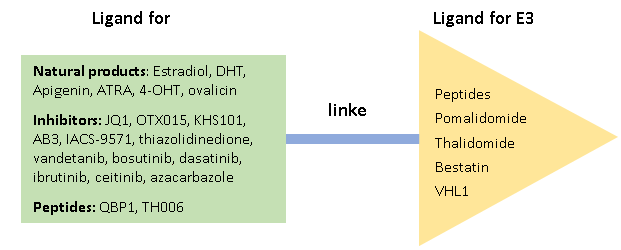Ligand Design and Development
Targeted protein degradation using PROTACs has emerged as a powerful therapeutic modality in drug discovery. PROTAC molecules consist of two different ligands: one binding to the protein of interest (POI), and the other binding to E3 ubiquitin ligase. PROTACs bind to both the POI and an E3 ligase to form a ternary complex. Then POI ubiquitylation takes place subsequently. When the ternary complex dissociates, polyubiquitinated POI undergoes degradation by 26S proteasomes. This type of POI degradation can be repeated simply by dissociation and diffusion of the PROTAC ligands. As such, PROTAC ligands can act like a catalyst that is effective even at a low concentration. PROTAC technology has opened the way for the proteins that are often out of reach for traditional therapeutic approaches based on inhibition.

Figure 1: Examples of the PROTAC ligands that bind to the POI and E3 ligases.
An E3 ligase can recruit an E2 ubiquitin-conjugating enzyme and help transfer ubiquitins from E2 to the protein substrate. There are approximately 500-1,000 E3 ligases in human cells. Still, only a few have been identified and used for PROTACs, which include Von Hippel-Lindau disease tumor suppressor protein (VHL), the Cellular Inhibitor of Apoptosis (cIAP), the Mouse Double Minute 2 Homologue (MDM2), and ereblon (CRBN). Early PROTACs used the HIF-1a peptide fragment bearing a cell-penetrating peptide sequence to recruit VHL E3 ligase. Later on, other small-molecule ligands have also been developed for binding E3 ligases, such as the MDM2-p53 PPI inhibitor nutlin for recruiting MDM2, and the immunomodulatory drugs thalidomide and pomalidomide for recruiting CRBN.
Many PROTACs have been developed to degrade the target proteins, including kinases (such as CDK, KARS, MEK, and Bcr/Abl). Transcription factors (such as p53, STAT, RAR, ER, and AR), epigenetic tools (such as HDAC and BET bromodomain), and E3 ligase themselves (such as MDM2). In general, ligands with higher affinity are preferred in PROTAC development. But any ligands with higher than ~1 uM Ki have a good chance of working. To identify the optimum vector for ligand attachment, it may be necessary to screen many alternatives. For example, in designing PROTACs for MCL1 target protein, various attachment points have been explored.
To promote the progress of PROTAC development, Profacgen is dedicated to providing high-quality and one-stop services for ligand design and development.
Our services include but are not limited to:
- Ligand design for E3 ligase and target proteins
- Custom peptide and compound ligand synthesis
- High throughout ligand screening
- ADME/Tox prediction
- 3D-QSAR
Our advantages:
- Integrated in silico and experimental services
- Multiple ligand-design services for the assigned targets
- Advanced ligand synthesis platform
- Highly efficient ligand screening process
- Detailed report with results and analysis
Please contact us for more details. We are more than happy to generate a tailored proposal for you based on the specific requirements.